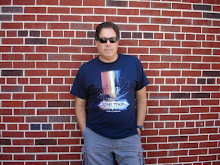
(February 1933, U.S.)
There is a particular art house movie theater in Greenwich Village, New York City called the Film Forum that I have frequented from time to time whenever I wanted to see a vintage revival on screen. Back in 2009, when we were knee-deep in our economic recession, the theater screened a series of films and double features under the theme of "Depression Era" films. One of these double features was the original version of KING KONG (1933) and...you guessed it...42ND STREET. By way of story, the two of them obviously have nothing to do with each other, except the locale of New York City during the time of the Depression when economic struggle of the comman citizen was at it's highest in history. 42ND STREET, for it's era, has all the glamour and the glitz of the magic of Broadway, but also manages to stress the idea that America is in a Depression and that stage performers, like the common citizen, are struggling to work and survive, as well.
Now you've heard me say more than once that I generally don't like musicals, and I still don't. However, when you're dealing with a story about a stage production, it's a story where song and dance go hand-in-hand with the exhausting daily grind of bringing a new musical stage show to life. In other words, actors and actresses are not just breaking out into song and dance like some bad episode of GLEE. The music and dancing is part of the show and therefore an essential part of the working film. To be perfectly honest, though, the songs are incredibly dated and corny and I find most of the dancing that takes place to be rather mechanical looking. On the other hand, it's the intense drama of the dancers and the show's director that keeps your attention going throughout the film.
In noting the era of the early 1930s when this film takes place, I have to point out that the characters we see behind the production are absolutely NOTHING like the stereotypical effeminate gay men you'd likely see on screen today. The director Julian Marsh (played by Warren Baxter), much like Roy Scheider in ALL THAT JAZZ (1979) is harsh and demanding but also the best at what he does. And even though it's a era of movie innocence, you can't help but get the feeling he'd sleep with every dancer in the chorus if he could. The show's assistants are not what you'd expect, either. They actually dress and talk like Prohibition gangsters rather than traditional Broadway lyricists and choreographers. Go figure.
One of the particularly interesting things I have to also note about 42ND STREET is watching its original trailer. This was a film that was released only a few years after talking pictures ("Talkies") were all the new rage. It was being billed as a spectacularly new screen experience. Yes, for its era, it's quite possible 42ND STREET was one of the earliest screen blockbusters out there...and it WASN'T in 3D!
Favorite line or dialogue:
Andy: "How's the turnout, Mac?"
Mac: "About fifty-fifty. Half are dumb and the other half are dumber!"


No comments:
Post a Comment